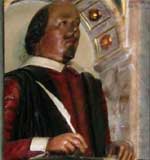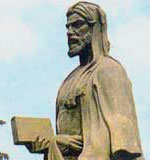DAWN Images August 21, 2005
Romeo and Juliet: An Immortal Love
Story
 |
 |
| Above
left: Monument of William Shakespeare (Straford0upon-Avon,
UK) Right: Monument of Nizami Ganjavi (Baku, Azerbaijan). |
Romeo and Juliet have come to
characterize youth and youthful love. We know them through William
Shakespeare, and the immortal lines that he put in their mouths,
such as “What we call rose would by any other name smell
just as sweet.” The lines are his, and so is the masterful
treatment of the plot.
The story, however, goes back to at least more than a thousand
years before Shakespeare, and the Elizabethan audience knew
it in at least five different versions before Shakespeare was
even born. His claim to fame rests on the way he used his craft
to retell this well-known story — and indeed retelling
an old story was a norm rather than deviation in those days.
Since times immemorial, many
imaginations were haunted by a pair of unfortunate lovers, the
female of which should commit herself to a dagger at the tomb
of her untimely deceased lover. This was the central motif in
the story of Pyramus and Thisbe, narrated by the Roman poet
Ovid in the second century before Christ (Shakespeare himself
parodied this tale in A Midsummer Night’s Dream). This
primordial folk tale perhaps also gained currency in Persia
and affected the handling of the semi-historical love story
about a 7th century Persian Emperor Khusrau Pervez and his Armenian
Christian wife Shirin (Irene). The definitive version, written
around 1191 by the Persian poet Nizami Ganjavi, threatened Shirin
with a distasteful marriage after Khusrau’s murder and
she, much like Thisbe in Metamorphosis, asked to spend a night
on her lover’s tomb, killing herself there with a dagger.
Nizami also introduced Farhad, a sculptor who falls in love
with Shirin while Khusrau is still courting her. He has to be
prevented by false news of her death. Dismayed, he kills himself
with a pick axe.
After passing through the Hellenistic
and Latin hands the story now picked up a little bit of Persian
mysticism: Farhad’s end serves as a mirror to Shirin’s
own impending suicide. They both die from the same tragic flaw
— too much love for ‘the other’ — but
while he fails to see falsehood from truth, or appearance from
reality, she at least dies for a real cause. The influence of
this Persian version on the later romances that eventually served
the plot for Romeo and Juliet is unrecorded but not unlikely.
It is mindboggling to think that these two love stories, one
so eastern and the other so western, were both derived form
a single source.
Spain was the crossroad of civilizations
between Islam and the West. The influence of eastern, especially
Muslim, storytelling on the early Spanish literature is well-recorded.
In 1476, the story of unfortunate lovers found a new version
in Il Novellino (The Novel) by Spanish writer Massucio of Salerno.
Here, Mariotto and Giannozza, a boy and a girl from Siena, secretly
marry with the assistance of a friar. The boy kills a prominent
citizen in a quarrel and is exiled to Alexandria while the girl
avoids marriage to a suitor of her father’s choice by
taking from the friar a magic potion (traceable in literature
at least as far back as Ephesiaca by Xenophon of Ephesus in
the fifth century A.D.). The potion puts her to a death-like
sleep, she is sent to the tomb, rescued by the friar and eventually
sent on her way to Alexandria. Her beloved husband, however,
doesn’t receive the news since the messenger is intercepted
by pirates, returns to Siena, gets caught and is executed. The
girl returns heartbroken, goes to a nunnery and dies of grief.
The name Romeo was given to this
character in Luigi da Porto’s novel published around 1530.
It was adapted, of course, from the Spanish Il Novellino. Luigi
shifted the scene from Spain to Italy and made some other changes,
too. The city is Verona. Romeo and Guilietta come from two feuding
families, the Montecchi and the Cappelletti. They meet at a
carnival ball (where a minor character Marcuccio is also present),
Romeo forgets his previous unrequited flame, and the friar who
marries them is called Lorenzo. The gentleman whom Romeo kills
despite earlier hesitations to fight is named Theobaldo Cappelletti,
the city to which Romeo is banished is Mantua, and Lorenzo’s
messenger who fails to deliver the crucial update is a fellow
friar. Romeo carries a poison when he returns to Verona after
hearing about Guilietta’s death, Guilietta wakes up in
time to hear him speak, afterwards refuses the friar’s
advice to go to a nunnery and dies by stopping her own breath.
This Italian version was called Historia novellamente ritrovata
di due Nobili Amanti.
In 1554, the story of Romeo and
his girl reappeared in the Italian writer Matteo Bandello’s
novel, Novelle. Changes occurred. For instance, Romeo goes to
the ball in a mask, the minor character there is named Mercutio,
the heroine’s name is Julietta, she is 18 years old and
has a nurse. Romeo’s premarital visit to Julietta’s
chamber is engineered by providing a rope ladder to the nurse.
The poison he uses in the end is purchased from one Spolentino.
In 1559, the story of Romeo and
Julietta appeared in French when Pierre Boaistaua included it
in his Histoires Tragiques. He translated it from the 1554 novel
by Bandello. However, the character who sold poison to Romeo
was described here as an apothecary (later racked and hanged).
Romeo dies before the heroine Juliet (as she is named in this
French piece) wakes up and she, just like Thisbe and Shirin
of the earlier stories, kills herself with a dagger (Romeo’s
in this case).
By this time or shortly afterwards,
the story became popular in England. At least the contemporary
English poet Arthur Brooke saw a play about the two lovers on
the British stage sometime before 1562. In 1562, he published
a long narrative poem called The Tragical History of Romeus
and Juliet. Although he claimed that it was adapted from the
Italian version of Bandell, it was in fact taken from the French
adaptation. William Shakespeare, born two years after the first
publication of Brooke’s poem, evidently consulted it for
writing his play when he grew up. The poem opened like this:
There
is beyond the Alps a town of ancient fame
Whose bright renown yet shineth clear.
Verona men it name,
Built in an happy time, built on a fertile soil,
Maintainid by the heavenly fates and by the townish toil...
There were two ancient stocks, which
Fortune high did place
Above the rest, endued with wealth and nobler of their race,
Loved of the common sort, loved of the Prince alike —
And like unhappy were they both when
Fortune list to strike — Whose praise with equal blast
Fame in her trumpet blew.
This should remind us of the
famous prologue of Shakespeare’s play (written 30-37 years
later), “Two households, both alike in dignity, In fair
Verona, where we lay our scene, From ancient grudge break to
new mutiny, Where civil blood makes civil hands unclean.”
Brooke named the two contesting
houses Montague and Capilet, the hero was named Romeus, Juliet
was a rather scheming creature (although her age was reduced
to 16), the nurse became occasionally comical but remained unattractive
and the narrative was spread over nine months. Juliet’s
kinsman whom Romeo kills unwillingly was named Tybalt. Mercutio,
the gentleman who hits on Juliet at the ball before she falls
for Romeo, became quite memorable but remained a minor character.
Despite sympathizing with the lovers, whose deep kissing at
the very first meeting was graphically described, Brooke disapproved
their carnality and haste. In the scene where Romeus talks to
Juliet in her balcony, abstinence from premarital sex was a
greater concern than love itself.
Four years after Brooke’s
poem, William Painter included the story in The Palace of Pleasure,
published in 1566. We do not know when Shakespeare wrote his
play Romeo and Juliet, but it is commonly assumed to be sometime
between 1592 and 1596. It is likely that he also consulted Painter’s
work of 1566, but his familiarity with the relevant foreign
novels remains uncertain. The old play (of 1559 or later) may
not have been available to him and almost certainly would be
of no use. He reduced the age of Juliet to a little less than
14 (which should correspond to the age of his own daughter,
Susanna, if the play was written in 1596), and restored the
hero’s name to its 1530 Italian version, Romeo.
Brooke’s poem of 1562 was
obviously the main source and the play mostly runs parallel
to it. The kissing scene in the source poem turned into a tongue-in-cheek
repartee between Romeo and Juliet (but not with Romeo’s
tongue in Juliet’s cheek, unlike in the source poem).
Later again, where Juliet tries to find out about her anonymous
lover with the nurse’s help, Shakespeare kept the ethos
of the source poem but spruced it up for the stage, using that
mastery over stagecraft in which no one was ever able to surpass
him, before or after. He compressed the narrative to a few days,
moving the events at a fast pace and introducing Tybalt and
Paris earlier in the story, enhanced dramatic unity.
Of course, all characters got
a doze of Shakespeare’s fresh DNA. Mercutio, instead of
hitting on Juliet (as in the source stories), becomes Romeo’s
unforgettable friend whose dramatic presence should dwarf Romeo
himself if he wouldn’t die halfway through the play (cursing
“a plague o’ both your houses”). The nurse
became the untiring provider of bawdy jokes and hearty laughter.
The moral condescension of Brooke
had to go. The lovers, allowed by Shakespeare to be themselves,
turned into the two dramatic characters that were probably the
best known and best loved in the entire history of imagination.
The scene where Romeo addresses Juliet while she stands high
in her balcony was by no means original to Shakespeare since
it also featured in Brooke’s poem, but in Shakespeare’s
hands it reached a perfection that cannot be surpassed. No one
can ever forget it after once watching it on stage, in film,
or in print:
Romeo: Lady, by yonder blessed
moon I swear, That tips with silver all these fruit-tree tops
-
Juliet: O, swear not by the moon,
th’ inconstant moon, That monthly changes in her circled
orb, Lest that thy love prove likewise variable.
Romeo: What shall I swear by?
Juliet: Do not swear at all;
Or if thou wilt, swear by thy gracious self, Which is the god
of my idolatry, And I’ll believe thee.
The story lives on, mostly in
the immortal lines of Shakespeare, but also in other adaptations
such as operas and, of course, the remarkable Hollywood musical,
West Side Story (1962). We need not mention the various other
film versions, since they are too well known already, but the
one directed by Zeffirelli in 1969 is usually regarded as the
best representation of Shakespeare’s work on screen. The
other one, starring Leonardo DiCaprio, is memorable for adapting
the entire script to the modern setting, without changing dialogue.
The treatment of this story,
and the conjecture about Shakespeare’s writing of it,
was however far from authentic in Shakespeare in Love. No doubt,
the screen biographical about Shakespeare was very engaging
and well deserved the acclaim and popularity it received. However,
it failed to represent even the most basic values and devices
that used to aid the creative processes of an Elizabethan playwright.
The path to the understanding
of Shakespeare’s immortal superiority lies in accepting
the fact he lived in an age where perfection was a more important
value than originality. And in perfection he excelled.

